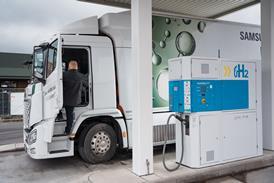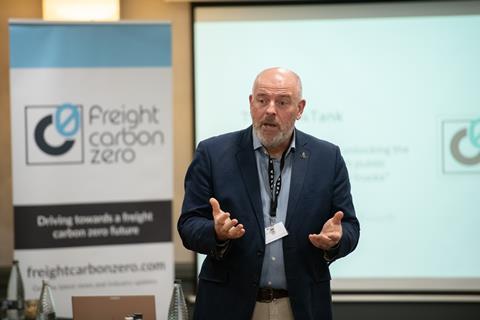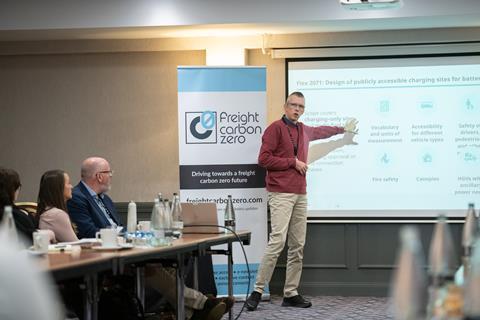Earlier this year, we partnered with Volvo Trucks and a number of key stakeholders in the road freight decarbonisation space to hold a Freight Carbon Zero Think Tank, a special workshop attended by a selected group of commercial vehicle and road freight stakeholders, to discuss the key challenges and concerns relating to the rollout of available infrastructure and access to the charging network.
Special thanks to all those who took part in the lively discussions and to James Nankivell and Jason Smallwood from the freight and logistics team at WSP for facilitating the sessions and keeping the discussions on track.
Following an initial introduction from Amy Stokes, Head of eMobility at Volvo Trucks and Brian Robinson from BJR Solutions who presented the initial findings from a piece of work BSI Solutions has been working on to develop a new code of practice for designing public charging sites, the group separated into two workshop streams. The first group focused on the infrastructure and physical practicalities associated with the public and shared charging network, while the second group focused on the systems and processes required to deliver a functioning charging network.
Introducing our ”Think Tankers”
Group 1: Infrastructure focus
A lively Think Tank breakout session explored the complexity of creating a charging infrastructure network for electric trucks.
Led by Jason Smallwood, Technical Director – Freight at WSP, the session brought together stakeholders from energy suppliers and infrastructure builders, through to fleet operators, rental firms, and trade associations to tackle the challenges faced by industry.

Some key themes quickly emerged: location; physical site layout; investment certainty for both infrastructure builders and fleet operators; and energy demands from the grid.
Threading together all the themes was the need for industry-collaboration - on a never-before-seen scale - to enable the industry to realistically achieve its net zero ambition.
Location, location, location
Picking the correct place to build public-access electric HGV charging infrastructure is imperative to maximise vehicle throughput, reduce wasted road mileage, provide easy access to major routes and make it commercially viable for investors.
Our Think Tank discussions emphasised the importance of strategically selecting locations for electric truck charging infrastructure.
Start with the obvious
- Focusing on major freight corridors and routes between key logistics hubs, such as ports, distribution centres and large industrial parks was an obvious starting point.
- There was debate about the pros and cons of adapt existing motorway service areas versus building new, dedicated truck stops.
- Motorway services offer existing amenities for drivers, but often have space constraints. There would also be additional health and safety considerations due to public access.
- Purpose-built truck charging hubs could be optimised for EV charging and provide driver amenities; however, they would require more investment to get off the ground from scratch.
Participants, not surprisingly, agreed that a mix of both would likely be needed.

Make better use of existing data/telematics
The group discussed the need to overlay multiple data sources to identify optimal locations, including traffic flows, existing truck stops, grid capacity data, and freight origin-destination patterns. Government agencies like National Highways and the Office of the Traffic Commissioner were cited as having valuable data to inform location planning.
Darren Newman, Director at the Low Carbon Truck Consultancy, said: “We know where trucks are parked overnight, because of operator licences, we have DfT statistics on how many vehicles of each different type use which roads,” he explained.
“The Centre for Sustainable Road Freight, for example, has just launched a dataset, which is publicly available. So, in terms of accessing all this information, it’s getting the right people to collaborate and understand where the demand will be and where the supply is coming from.”
Peter White, System Development Engineer, National Grid, added: “Once you get the data on the throughput of these truck-stop hotspots, you can crudely equate that to how much power you need at each site.”
“You can then start to plan for the future and understand what the transition to EVs is likely to look like in the long term,” added Adam Lakey, Stakeholder Engagement at UK Power Networks. “And you can start to understand what that transition looks like right up to 2050, so we can plan to provide the right amount of capacity at these locations, assuming that they are the right locations.”
With several Think Tankers already involved in separate data-led projects on the topic, it was deemed essential to bring all the findings together and overlay them to map out optimal charging locations.
Smallwood said: “If such a map existed - and land was made available by local authorities through appropriate, aligned planning policy – this would give investors and infrastructure companies the ability to take that space and invest in it.
“They would then know that it probably was in the right location and would have the commitment from local authorities to support a new site.”
Ensure UK-wide coverage of HGV charging infrastructure
Whilst data mapping can help determine the hotspots – such as major distribution centres, key arterial routes and popular truck-stops – it is still essential to ensure charging infrastructure can be accessed in remote, lesser travelled locations.
However, without a guaranteed throughput of vehicles, it is unlikely an infrastructure provider will want to invest heavily in building a new site in a remote location. Multi-million-pound investments are often required just for the grid connection and on-site power equipment. This impacts the commercial viability of sites, especially in the early market stages with lower utilisation. Government support may be needed for some strategically important, but less commercially attractive locations.
The long-term nature of these investments means charging providers need certainty on land access and customer demand to justify the upfront costs. “Those sites will be a much lower return on investment,” said Newman. “For me, there needs to be some intervention from government to make sure we’ve got an equal distribution, and we don’t get everyone putting all the chargers into the profitable places in the middle where lots of people go. We need to facilitate journeys to all four corners of the country through infrastructure.”
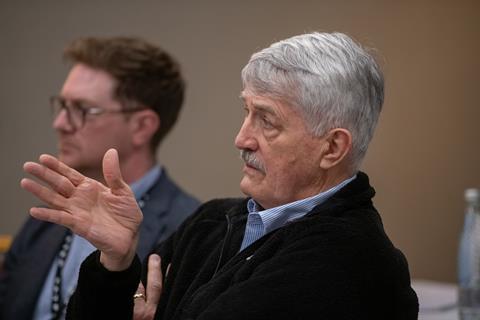
There also needs to be better co-ordination between national government and local authorities on planning and zoning strategies, the group agreed. This includes educating planners on the power needs and impacts of large-scale truck charging. “Local planning needs to be on the same page as national government,” urged White.
“It’s really exciting to see so many engaged people in the room today pushing ahead with the decarbonisation of HGVs. We have 27 zero-emission HGV models, so you can see the manufacturers have really invested.
“The difficulty we have is the lack of charging infrastructure. It’s difficult to put it in the depot, there’s one public charge point for HGVs in the country and we’re waiting for a strategy from government that will explain how things are able to move forward.
“We need to make access to energy easier and provide a consistent planning framework that enables businesses to move forward and make plans without too much red tape.”
Sukky Choongh, SMMT
Layby challenge
Our Think Tankers pointed out the reliance on laybys for 25% of HGV drivers needing to take their legal breaks in current diesel vehicles. Drivers in electric trucks may need to combine their regular stops with the ability to charge their vehicle, be it using rapid charging for a 45-minute rest stop, or to charge while parked up overnight.
This would exacerbate the severe shortage of truck parking capacity in the UK and is something that needs to be factored into infrastructure capacity planning.
Certainty of investment
Collaboration was deemed essential to solve the chicken and egg conundrum facing fleet operators and charging hub providers. Operators are reluctant, or indeed unable in the case of most SMEs, to transition to electric trucks without the certainty of public-access charging facilities. On the flipside, infrastructure firms need to be confident that demand exists for potential sites, such as the securing of a substantial anchor tenant, before investing millions into a project.
Smallwood said: “The thing that struck me most of all was the real need for collaboration across the public and private sector and the level of certainty that’s needed for the market to invest.
“I think there’s a really important role for government and local authorities to provide that guidance, and that certainty will allow those investors to really get stuck into providing the solutions that already exist, largely.”
Alex Baker, Mobility Advisor at Fleete Group, added: “For me, it’s making sure that the dealers, the OEMs, the fleet operators and ourselves are all around the table and saying ‘Okay, well if we do this, what does that mean to you? And if we give you this timescale, will you give us a commitment to enable us to get spades in the ground and make it happen?’
“The solution is very much collaborative. Let’s put a strategy together between us and make it happen that way.”
Dawsongroup pointed out from an operational perspective many fleets had been disadvantaged by previous unfulfilled infrastructure commitments when it came to alternative fuels such as Bio-LNG and Bio-CNG and they now required certainty before investing in electric vehicles. Matt Watson, Head of Fleet at the hire specialist said: “We need to have genuine commitment from charging point providers of what infrastructure will be provided. This is going to be needed to move forward, because we’re making massive capital commitments on trucks.”
There was discussion of the role government could play in creating investment certainty, such as by designating strategic charging locations or providing funding guarantees.
This was seen as essential for all stakeholders, from hauliers through to energy providers.
“We are waiting for a strategy from government that will explain how things are able to move forward. We need this urgently to give certainty to hauliers that often work on very low margins. We want to make this transition affordable and easy for them,” said Sukky Choongh, Environmental Manager at the Society of Motor Manufacturers and Traders (SMMT).
Regarding funding, our Think Tankers agreed that extending the remit of the government’s £950m Rapid Charging Fund, aka ‘Project Rapid’, to include HGVs, would be a sensible first step. It currently only includes cars and vans. Some Think Tankers even believed the entire funding allocation should be ringfenced for HGVs.
“We’d also like a review of how funding is allocated for both vehicles and infrastructure so we can achieve a completely decarbonised freight sector in the UK,” Choongh added.
Participants emphasised that while collaboration is crucial, it needs to be streamlined to avoid slowing down progress.
’Speed dating’ style quick connections between relevant parties was suggested as preferable to large, slow-moving coalitions.
There were also calls for neutral industry bodies (or government agencies) to help facilitate collaboration and data sharing in a way that does not disadvantage any individual company.
Site and design considerations
Making best use of space to drive efficiency into any new truck charging site was an important theme of the session. Our Think Tankers discussed some essential areas to optimise site efficiency.
There was recognition that electric truck charging will undoubtedly require more space than currently needed for diesel fuelling at sites. Separation from other vehicles, if charging is placed at a shared-user public-access site such as an MSA, is also crucial. This could potentially include ANPR entry control barriers, fencing, or additional security measures.
Exploring a drive-through model could also be advantageous to traffic flow on a site, our Think Tankers agreed.
Standardisation
“As a user of these charge points, what’s important to us is having a commitment from the providers of the charge points, but also from the manufacturers, of uniformity and compatibility across all these sites,” explained Watson.
“Otherwise, as a user, I’m going to commit to doing my own depot structure as the public charging will be too risky: I won’t know if when our trucks arrive at one, they will be able to charge - because maybe it’s charged on the wrong side, or perhaps it doesn’t have the right security system. These sorts of things must be covered off because otherwise the investment is going to have to be made purely for private depots.”
Many participants emphasised the need to standardise the location of charging sockets on trucks to enable efficient site layouts.
Joe Ellwood, Electric Truck Charging Manager at Volvo Trucks, said: “If you’ve got a mix of trucks coming into a charging hub with the sockets in different places, you can either, as an extreme, end up with only 50% of your charging base utilised, or you have to build in 100% redundancy and put two sockets in for each vehicle.”
The position of the MCS (megawatt charging system) input port is currently defined as behind the left front wheel at hip height, whereas the CCS (combined charging cycle) input port used for overnight charging, can be located anywhere around the vehicle.
This causes difficulties in maximising the use of space at a site. It can also inhibit inclusivity for drivers, due to the physical demands of pulling a heavy charging cable around to the opposite side of a vehicle if the input port is located there.
“If you want to optimise the amount of real estate you’re taking up, we need to get both MCS and CCS legislated so that they’re adjacent to each other, then we can harmonise both LCVs and HGVs. And I think that is essential,” added White.
Tesla was cited as a good example of maximising real estate through use of a standardised input port.
In addition, our participants could see the benefits in exploring the concept of a standardised, modular approach to design, from the types of cables used through to the amenities offered to drivers. Such a modular approach could maximise site optimisation and prove easier to scale up as future demand increases.
Although not the main focus of this working group, it was also mooted that consideration was given to the idea of a capped pricing model for charging sites, to prevent the scenario where a driver might be forced to recharge at a much higher rate than expected due to lack of other nearby options. Fluctuations in public charging pricing could also affect TCO models of electric vehicles, which would be problematic for fleet operators.
“You need to be able to use a figure to say roughly it’s going to cost me X pence per kilowatt,” explained Watson. “Otherwise, you’ll make a business case to buy electric trucks and then it’s completely blown out when you realise that it’s costing you twice as much.”
Driver facilities
Think Tankers agreed that the creation of new HGV charging infrastructure was an ideal time to tackle the challenge of inadequate and poor standard driver facilities. This could potentially attract more drivers into the industry. A commitment to a minimum level of driver facilities and service level provision was deemed sensible.
Making the experience as seamless as possible, especially for drivers wanting to do a quick top-up charge and get back on the road, is essential, thought some of our participants.
“You have to make it as easy as possible for the lorry driver, as they have to buy in to the concept of electric trucks as well, “said Callum Matthieson, Group Sales Director at Cleaner EV.
Gareth Legg, Operations Director at manufacturer ECON Engineering, added: “The drivers already love the trucks, but if they can pull in, charge and go then they will be happy. They need the guarantee of an available slot as well.”
Balancing speed and dwell time
There was discussion on the need to balance the provision of rapid charging for quick turnarounds with slower charging for longer stays. With drive-through charging for the former and overnight camper-style hook-ups for the latter.
Power requirements
A major challenge for new infrastructure is ensuring sufficient grid capacity exists to support high-power charging for multiple trucks simultaneously. For overnight depot charging, lower power AC charging may be sufficient. But for en-route rapid charging, very high-power DC chargers in the megawatt range will likely be required to charge trucks in 30-45 minutes.
The total site power needs depend on the number of chargers, expected utilisation, and whether car/van charging is also offered. Large truck stop sites could potentially require 10-20+ MVA (megavoltamperes) connections. Many existing sites may not have enough available capacity and significant grid upgrades are often needed to accommodate megawatt-scale charging installations. This can often be the case in large industrial parks where there are already huge demands on the grid.
Site Selection
Power availability is a key factor in site selection for charging hubs. Proximity to existing high voltage infrastructure can significantly reduce connection costs and timelines. For the largest charging installations (5-plus MVA), having nearby grid capacity is essential, whereas for smaller (less than 1 MVA) sites, the participants noted there is more flexibility.
Think Tankers discussed overlaying grid capacity data with other site selection criteria like proximity to freight routes, ports, and distribution centres. This helps identify optimal locations that balance power availability with operational needs.
Baker explained: “For example, if we’re going to be putting in five megawatts of charging, then we need access to the grid, we need at least 25 years plus lease on the land, we need to know we have got a good chance to get planning permission and so on. We need that level of certainty.
“On the smaller stuff, we’re willing to take a bit more of a punt. Where we’re putting in, say, one megawatt over a few days, based around a traditional truck stop, then it’s going to be hundreds of 1000s, rather than millions of pounds-worth of investment.”
Length of land lease is of key importance to distribution network operators (DNOs). With the high costs of installing new infrastructure, many would be reluctant at present to do so on a site with a short lease and, in an ideal world, would prefer freehold land. One solution to this is a modular substation that can be relocated, if necessary, therefore eliminating some of the risk of building on leasehold land.
Engagement and planning ahead
Our Think Tankers all agreed that early engagement with DNOs is crucial.
Long lead times for major grid upgrades were highlighted as a key challenge, with some potentially being more than two years. This can have an impact on site selection and rollout strategies.
White urged all industry stakeholders: “Whether you’re a fleet or a charging hub provider, engage with your DNO as early as possible, because the journey to get the capacity will be a whole lot easier. If you leave it until 2359 and you need it at 2400, it’s going to be ‘Houston, we have a problem’.”
Phased capacity growth was discussed as one possible solution to combat high costs and long lead times for grid upgrades. Sites could start with a smaller power connection initially and scale up over time as demand increases.
Some DNOs are open to “ramped capacity” agreements, where capacity is increased over time as demand grows. This allows charging providers to secure future capacity without paying for it all upfront.
This aligns with the expected gradual transition of truck fleets to electric.
There was also discussion around the need to future-proof sites by securing more power capacity than immediately required. This avoids having to do repeated expensive upgrades as demand grows.
The DNOs taking part stressed the importance of fleet operators having long-term electrification plans with clear timelines. This allows infrastructure providers and DNOs to plan appropriate phased power upgrades.

Energy demand
The need to consider time-of-use of energy demand was raised, particularly for sites combining overnight depot charging with public charging. Time-of-use electricity pricing and smart charging can incentivise shifting demand to off-peak hours where possible, reducing peak power needs.
Baker said: “We’re working with a number of larger customers and looking at their own depot power - so providing depot charging - but also providing a dual approach: they use it at night, or use some of it at night, and then it’s available to anybody else during the day.”
It is also important to consider the additional capacity and charge during peak times.
This should examine not only peak logistics activity periods, but also peak tourist periods – as not only do these create demand from private vehicles but also for HGV deliveries and subsequent charging.
These tourist areas might be in a rural or remote location where grid capacity isn’t as secure in terms of capacity.
Generation and storage
Battery storage systems could help manage peak loads and reduce the required grid connection size. This may be especially relevant for sites with constraints on available grid capacity. Smart charging and power management systems will also be crucial to optimise the use of available power capacity. These can balance loads across multiple chargers and vehicles to stay within site power limits.
To supplement grid power and potentially reduce connection costs, on-site renewable generation and energy storage were mentioned as options.
Group 2: Systems and Processes
The second workshop stream at the Think Tank, led by WSP’s James Nankivell, focused on the systems and processes associated with the implementation of a publicly available shared network of HGV charging stations.
The discussion focused on the challenges and solutions for electric vehicle (EV) charging infrastructure. Key points included the need for quick response times, with repairs needed within an hour, and the importance of rerouting when charge points are unavailable. The conversation highlighted the necessity of high availability, with a focus on communication between operators and planners.
The group discussed the integration of charging availability with route planning and the potential for mobile high-power charging. They also emphasised the importance of predictive charging, smart load balancing, and demand forecasting. The need for a unified booking system and the challenges of managing multiple charging systems were also addressed.

Network availability
The discussion kicked off on the topic of availability, highlighting the industry’s concerns about both the reliability of the network and how the availability of charging capacity can be assured at public charging sites. This is particularly acute in the short-to-medium term as the confidence in electric vehicles builds and the network of available chargers will be relatively fragmented, the group agreed.
Service level agreements with suppliers
Amy Stokes, Head of eMobility at Volvo Trucks, summed up the sentiment of the workshop Think Tankers on this point: “If a fleet operator turns up at a charge point and it isn’t available, then they won’t ever use that charge point again,” she said. “Those businesses that don’t ensure the availability of their charge points will go out of business in the medium term, but the problem we’ve got in terms of the transition is that this causes a lack of confidence in the whole technology.
“We do need to think about what the end solution looks like, but the industry has got to think realistically next year and the year after about the fragmented systems, and what level of communication has to happen to avoid a poor experience.”
For the charge point operators (CPOs) this means ensuring the highest levels of charger availability and service level agreements which will deliver quick response times if things go wrong, said Brian Robinson. “The response times need to be very, very quick. If something’s not working, it needs to be repaired as a priority.”
The group agreed there had been some mistakes in the early installations, but the learning curve had been dramatic and awareness of the need for uptime guarantees and tight installation agreements was much more widespread.
When it comes to availability of the charging network Dave Rose explained that in the future there would be high levels of liquidity in the available charging network, as there is with diesel now “if there’s a fault with one station, you just move on to another,” he said, “but right now, and certainly for the foreseeable future, we are just going to rely on high availability of the chargers, because you just won’t have the liquidity for a long time.”
Routes to success
When chargers become faulty and stop working it’s important to have mitigation measures in place, agreed the group and the conversation went on to explore the viability of some sort of alert for drivers and operators to allow for the timely and effective rerouting of the vehicles where a fault occurs. This could be in the form of an App or could be directly linked to the in-vehicle telematics technology. Communication is key and these ‘messages’ need to be compatible with a wide range of routing systems that operators use. “In the short term, the truck operators will need to understand what available charging there is,” added Stokes, “so they can dynamically link into the work that’s coming in at the time when they’re planning it.”

Colin Ferguson is CEO at Optimize, a specialist in routing and scheduling optimisation, and explained this technology was a natural evolution: “The SLA around this point has to be about making sure that there’s a protocol that, from the start, gives the tech providers the data via an API that we can consume in systems and surface to the market in the scheduling tools,” he said, adding that he advocates a holistic approach to fleet electrification, rather than a fleet replacement plan, swapping diesel for electric. “Rather than just looking at a particular vehicle in isolation, with those challenges on that specific afternoon and then working out how to re-route for charger availability, we prefer to look at the whole picture of the fleet and the jobs that need doing, because it could change and we can deploy a different vehicle to do the job. That’s what happens today when something goes awry in an operation, we re-route for that incident. These are not new concepts.”
“By the time the driver turns up to charge and finds the charger is down, it’s too late,” agreed Rose. “This has to be part of the scheduling process whereby the scheduler already knows what charger any specific vehicle is going to be charging on at a particular time.”
“We also are in danger of falling into the mindset that whenever a truck stops, it’s going to be pulling in at 10% and it’s going to need to fully charge, like we do for diesel,” explained Brian Robinson. “There’ll be a whole load of trucks that only need to be there for 10 or 15 minutes because they don’t need a full charge. They just need enough to get back to the depot, or enough to complete their activity. This is a bit of a culture change from where we are today in the industry.”
While the operational use case for charger availability is clear, the group also considered that any “charge point availability protocol” for data sharing should be made public. This could encourage healthy competition between suppliers and raise the bar with regards to performance. Any CPO operating below the uptime threshold would then be challenged to improve.

Similarly, where fleet operators collaborate to create a shared user charging network, a set of agreements will need to be in place, explained Neil Trotter from Boughey Distribution: “If we’re going to invest in putting a charger in at our site, where we have lots of other hauliers coming through, we will need an agreement with those parties to a certain amount of power from us a year.”
“My main take home from today is having the customers’ buy in. And when I talk about ‘buy in’ it’s about giving the customer certainty to help them plan what their fleet transition is going to be over the next few years.
“The reality is that the haulage industry has a whole section that comprises family businesses who have done things a certain way for years., three or four generations that have always used diesel. Now they have to contend with diesel, HVO, hydrogen and electric – and quite frankly it’s a difficult decision for them to know which way to jump. They are not mandated yet.
“So I think there’s a huge gap between what we have to do today and what we have to do in 10 years’ time. And by doing everything we’ve spoken about today, I think it gives them the ability to plan for the future. They might not buy lots of electric trucks today, but certainly it’s going to be in their plans for the next 5-10 years.”
Callum Matthieson, Cleaner EV
Predictive charging and matching to the network
The discussion evolved into the advanced techniques aimed at enhancing the availability and efficiency of electric vehicle (EV) charging networks, identifying the locations for the charging sites and ensuring the network will be properly utlised.
Booking systems
Gridserve is the project lead for the Electric Freightway scheme, part of the DfT’s Zero Emission HGV & Infrastructure Demonstrator (ZEHID) programme and, as part of this work, has been developing a booking system for truck operators to secure a slot for their trucks on a public charger.
Sam Clarke is Chief Vehicle Officer at Gridserve and took the Think Tankers through the work so far: “We’ve been through hundreds of hours of modeling all the different facets of bookability and resolution,” he explained. “It’s a very complex project, with lots of data points to consider, many of which we have discussed in this session, but we’ve done that hard work now, and we expect to have a phased solution in place from the beginning of next year.
“It’s difficult to try and forecast what the utilisation metrics are going to be like when the vehicles are only just starting to deploy on the project. There’s a whole understanding of long dwell charging versus short dwell, how long people are going to need to be charging for, as well as the challenge of people who need to park and stay parked but aren’t necessarily going to need to charge for the duration of their stay.
“Connectivity with the vehicles is extremely important in the longer term, but the unpredictability of events is doable once you’ve got all the data streams that can help make informed decisions. We recognise the need to have different booking slot periods, be it an hour, six hours, 12 hours, and similarly we are seeking to understand the period within which you can change or cancel those as well.”
“We use lots of booking systems already,” explained Trotter. “Every regional distribution centre we go to has them. Typically, if you don’t arrive on time, some organisations impose fines, some don’t, but everyone gets really grumpy. A penalty model for missing your charging slot would just put people off massively. Better to link with telematics and manage the availability that way, as this would be preferrable.”
“When we send a truck out we’ve got a plan for the day,” says Voltloader’s Dave Rose. “We know exactly what percentage we’re going to be at what point in the day and where they’re going to need to charge and when. This can be quite precisely planned out. Certainly for the foreseeable future we’re operating in a very planned way and then managing the exceptions as they occur.”
Price caps on charging rates
The price to charge at the public charging network is a well-known issue in the passenger car sector, with most EV drivers in the room sharing stories of eye-watering public charging. Gridserve’s Clarke explained this was an inevitable consequence of public charging infrastructure. Indeed, it was felt the desire for fleets to avoid having to use the public charging network, as they do currently with diesel fill-ups at motorway services, would be a decisive factor in the usage of the network. “Let’s face it, most operators will want to avoid charging publicly, and will only want to take the energy needed to get them back to base for their cheaper electricity,” said Clarke.
That said, with an acute focus on vehicle operating costs, the costs of energy are under the spotlight, although the group was divided whether an energy price cap was the most effective solution: “I suggest we just strike through this point straightaway, because I just can’t see how a price cap is ever going to be implemented,” one of our Think Tankers (not a charge point operator) said. Others, however, felt there was some need to commercial protection, to prevent unscrupulous players exploiting the market and, potentially, creating barriers to the transition. If the cost was too expensive then operators will be slow to switch, or not switch at all. There needs to be fairness of pricing across the network.

EV Fleet is looking to develop a shared network depot chargers for fleets to plug into and is looking closely at protection on pricing, explained Shakeel Ali, from Evata UK: “We have proposed that any of our hosts shouldn’t price a charger at more than 52p/kWh. That’s cheaper than the public charging network, and could be an attractive option for fleet operators who are going to the expense of developing depot charging and need to offset that investment with an income source.“
Others felt it would be better to let the market decide: “The price at the charge point is driven by the wholesale cost per kilowatt hour, the cost of the physical infrastructure and then utilisation,” said Robinson. “Anticipated utilisation is a key driver. I don’t think a price cap is required. In a world where energy is cheap and utilisation is high, we can let the market get on with it. It’s only when electricity prices either go up again, stupidly, or anticipated utilisation is very low, that you’re going to hit trouble which may discourage people entering the market and you may need a mechanism to assist through subsidies or grants.”
New models of energy pricing
Having stumbled into a hornet’s nest on price caps, the discussion moved onto new energy solutions for truck operators: “We’ve had a number of conversations internally,” explained Ferguson from Optimize, “looking at new, emerging business models where our customers may want us to be buying energy on their behalf. We could build this into our commercial model.
“We believe there is merit in saying to a fleet operator, we’re going to take care of the energy side for you, we’re going to tell you when you need to charge and we can guarantee the charger is available and we’ll just build that into a monthly charge. For the customer, it just takes all the pain away and for the infrastructure operator, you’ve got a single point of contact.”
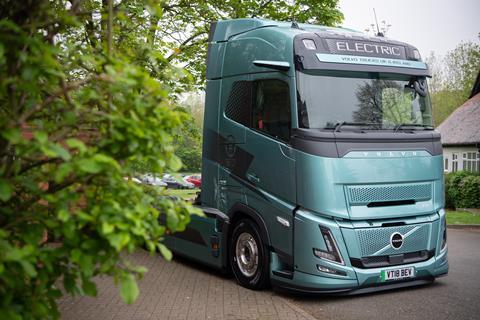
Supporting documents
Click link to download and view these filesFCZ Volvo Think Tank_WhitePaper
PDF, FileSizeText 0.13 mb

